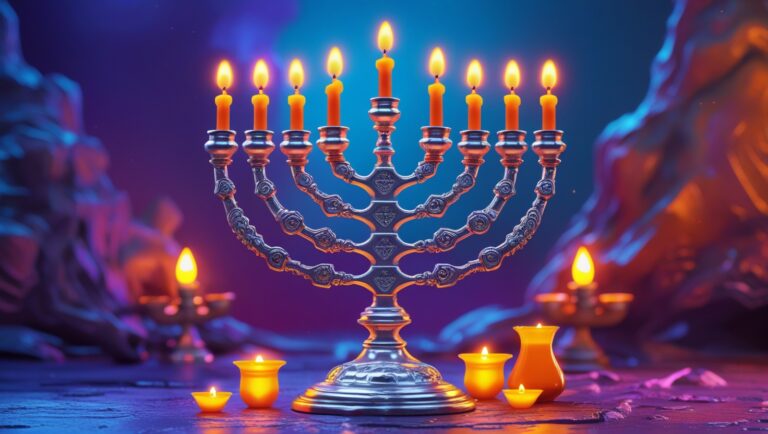Beneath the apparently simple Mitzvot of Purim there’s a treasure trove of awesome teachings from Kabbalah.
We all know this is one of the happiest festivals in the Jewish calendar, which commemorates the salvation of the Jewish people from the genocidal plot of Haman, an ancient Persian vizier. There was real danger back then because Achashverosh ruled the entire “civilized” world and his hand could easily reach every single Jew.
Most people are unaware of how wise the ancients, even our enemies, were. According to the Zohar, Avimelech king of Gerar was saved from his Ministering Angel (one of the 70) when he abducted Sarah Imenu. We can’t dwell too much on it now, but the Arizal interprets that when Haman said to Achashverosh “yesh am mefuzar” (there’s a people that is scattered), that he meant to say “their God is asleep [yashen huh], alluding to the dormita (slumber) of the Partzuf of Ze’ir Anpin marked by Mokhin D’Katnut (constricted consciousness). Meaning, Haman was no fool, he saw exactly when Hashem’s divine providence was the weakest.
But from here we learn the essence exile: when a person is asleep to his spiritual potential and can’t see the way forward or the big picture.
As a reminder, during the chag (festival) each Jew rectifies his own particular 5 Partzufim (spiritual systems) of A”K (Adam Kadmon) and ABY”A (the 4 spiritual worlds of Atzilut, Beriyah, Yetzirah and Assiyah) of the Sephira of:
- Chesed on Pesach
- Gevurah on Rosh Hashana, Sukkot, Yom Kippur and Shemini Atzeret
- Tiferet on Shavuot (also the Counting of the Omer)
- Netzach on Purim
- Hod on Chanukah
- Yesod on Tu B’Shvat
- Ateret HaYesod on Tu B’Av
- Malkhut on Tisha B’Av
This shows a little of the greatness of the work Hashem has given us. Imagine that every single Jew has a set of all these Partzufim to rectify which make up the klal of the Jewish People.
As we all know, Purim is a time of celebration, gratitude, and reflection, marked by the Four Mitzvot, and the 4 Parashiot (Torah reading portions), 2 before and 2 after the celebration.
Let’s delve into each of them a little:
The preparation and the 4 Parashiot
Each of the Mitzvot are aimed at bringing down the Mokhin of Gadlut to the Partzufim of that specific Avodah. According to the Arizal, the 4 Parshiot are therefore divided as follows:
- Shekalim: Chassadim D’Da’at because this is associated with the Chesed we do with Tzedakah with the half shekel.
- Zachor: Gevurot D’Da’at because this is associated with the war with Amalek which we must eradicate.
- Parah: Binah because the 5 Alefs (א) from the 5 Names EHYH (אהיה) that are in Binah come down to sweeten the Judgments (דין = 64) of the Parah [Adumah] (the red heifer), therefore turning them to the holy name of אדני = 65.
- HaChodesh: Chokhmah because Rosh Chodesh is the beginning of the months and all Chokhmah is called the beginning.
The festival of Purim is to a large extent linked to the destruction of Amalek. Amalek is the epitome of evil and symbolizes not only the Safek (doubt), but also the final barrier towards Geulah (redemption). It’s not by chance that Haman comes from Amalek, and the light of Purim will not cease even in Olam HaBah (world to come).
The 4 Mitzvot
In many places in the Kitvei Ari, we find that a special illumination comes once a year on Purim, which is the Ateret Yesod of Abbah (Chokhmah) from the Partzuf HaZemanim (of festivals). This light comes through Mordechai (מרדכי = 274) whose name is a contraction of the words Mor Deror (pure myrh) and is also gematria Rav Chesed (רב חסד = 274), alluding to the fact that we also receive the 13 attributes of mercy during the Megillah reading (as Rav Chesed is one of the attributes of God). Of course, Esther was also instrumental in bringing about the Geulah and symbolizes the illunmination of Yesod of Immah (Binah).
It’s noteworthy to remember that the reason why we do the Mitzvot the way we do is in order to elevate the fallen sparks of the Sephirot of the primordial worlds of Nekudim which shattered and rectify their corresponding Partzufim. Each and every year, Hashem “awakens” these fallen sparks so they can be elevated by us, and this is why our sages say “every year the Klipah of Haman comes to accuse the Jews”, because the sparks are also awakened.
And the way to fight against it is davka by doing the Mitzvot and recounting the miracles of Purim. This is why it’s so crucial to listen to the entire Megillah and not miss a single word, as well as perform the Mitzvot that increase love between Jews.
Interestingly, the Minhag of the Holy Rashash (Rabbi Shalom Sharabi) is to pray Shacharit at Netz with the reading of the Megillah. Then, immediately after the service to give Matanot LaEvyonim (gifts to the poor), Mishloach Manot (gifts to friends), and do the Seudah as soon as possible in the early morning. The reason is so that the “lights which are still very powerful after these 3 Mitzvot should become materialized by the Mitzvah of eating the Seudah. From the Kitvei Ari, we see that the corresponding prayer service is the Pnimiut (internal) aspect of the light while the specific Seudah is the Chitzoniut (external) aspect and this holds true throughout the year (hence the prohibition of eating before praying).
Presumably, the lights begin to wane if a person waits for too long to do the Seudah as this light of Ateret Yesod of Abbah is too powerful and fleeting to stay “in the air”. This is why Mordechai HaYehudi is Gematria Shadai שדי and both Mordechai and Ester (מרדכי ואסתר) together with the Kollel (+1) is Gematria 13 x the holy Tetragrammaton with the Miluy A”v (72) יוד הי ויו הי which equals = 936.
The very word Megillah מגלה = 78 is exactly 3 times the name YHVH (יהוה) which are a reference to the lights descending from that high level to the Partzuf of Rachel (the Shekhina, Malkhut) through the Netzach, Hod and Yesod of Immah.
The 4 Mitzvot, much like the 4 Parashiot, are also associated with the 4 Mokhin that we are supposed to bring down on Purim. Let’s have a look at them in-depth.
Let’s also add some Pshat to understand them better:
Reading the Megillah (Megillat Esther):
For those who are new to the blog, the Megillat Esther (the Letter of Esther) recounts the miraculous events leading to the deliverance of the Jewish people back in the days. The obligation to read the Megillah stems from the commandment to “remember” the events of Purim as recounted in Esther 9:28. The Megillah is read twice during Purim: once in the evening (known as “Megillah reading”) and again in the morning. The reading of the day is more important because that’s when we do all the Mitzvot together while at night it’s more like a Rabbinical remembrance.
This reading ensures that the story of Esther and the salvation of the Jewish people remains vivid and relevant across generations. Secondly, it serves as a reminder of the ever-present providence Hashem has for us even when all seems lost.
From Shaar HaKavanot:
“[When we read the Megillah] be Mekaven that it is an aspect of Shadai (שדי) Yesod D’Abba that enters Rachel and shines in her, and make all the holy names that she receives while inside, which are: 3 Names of VAHU (והו) from Netzach of Z”A (Zeir Anpin), 3 VAHU (והו) from Hod of Z”A and YEHU (יהו) from Yesod of Z”A. And 5 names HHH (ההה) from Tiferet Netzach Hod Yesod of Z”A. That makes 12 YHVH יהוה 9 from Netzach Hod Yesod of Immah and 3 from Ateret Yesod of Abbah.”
These names are encoded in the Rashei Tevot (first letters) and Sofei Tevot (last letters) throughout the Megillah but I can’t copy all of them here. Those who have a version of the Megillah from one of the Kabbalistic Yeshivot or that has the Kavanot will see them marked.
Matanot La’Evyonim (Gifts to the Poor)
Matanot La’Evyonim, or giving gifts to the poor, is another fundamental aspect of Purim observance. It is derived from Esther 9:22, which commands Jews to give gifts to the needy during the festival because “their eyes are set on this day to receive Tzedakah”.
This Mitzvah on a simple level, helps us rectify the Middot of empathy and compassion. Purim is a time of celebration, but it is also a time to remember those who are less fortunate. Some people have the custom to make very cheap Mishloach Manot to spend more on Matanot La’Evyonim. Unless a person really can’t spend decent money on Mishloach Manot, I don’t agree with this approach because it is still one of the 4 Mitzvot of Purim and we should honor it.
There’s also an idea from the Arizal to give money freely to whoever asks (without inquiring whether they deserve it or not) because this light of Ateret Yesod of Abbah is available to everyone. Just as we don’t want Hashem “inquiring” about our shortcomings to see whether we deserve it or not, so too, we should not inquire of others and just give freely.
The main Kavanah of Matanot La’Evyonim is to “sustain the vessels and lights of the external Partzuf“. The word Matanot (מתנות) has 2 Tavs ת given that they both come from Immah (unlike Mishloach Manot, see below).
The 2 Evyonim (poor) are the Netzach and Hod like the Arava (from Sukkot), which are lacking in taste and smell, and therefore called “poor”. Immah gives the Shefa through the secret of MiBinah Nevi’im (from Binah Nevi’im [prophets]). And Immah stretches up until Hod.
Mishloach Manot (Sending Gifts of Food)
Mishloach Manot entails sending portions of food to friends and family during Purim. Men should give to men and women should give to women. This mitzvah is based on Esther 9:22, which instructs Jews to send gifts of food to one another.
From Shaar HaKavanot, Rabbi Chaim Vital teaches us that with Mishloach Manot we draw down the light of Yesod of Abbah called איש (Ish), to Re’ehu (his friend) רעהו, which is the Yesod of Z”A. And it is known that Yesod of Abbah vests itself in Yesod of Immah before going down and therefore one needs to give 2 “Manot” מנות one from the side of Yesod of Abbah, which is מ״נ and one from the side of Yesod of Immah, which is ו״ת of Manot.
In Pri Etz chaim we see that these lights go down to Rachel (the Shekhina) as well and they are the Chassadim and Gevurot.
Seudat Purim (Festive Meal) and getting drunk
The Seudat Purim, or Purim feast, is a festive meal held during the day of Purim. It is a time for family and friends to come together, enjoy a lavish meal, and celebrate the miracles Hashem gave to us which are renewed every year.
In the tractate of Megillah (7b), the Talmud states, “A person is obligated to become intoxicated on Purim until he does not know the difference between ‘cursed be Haman’ and ‘blessed be Mordechai’.”
The Shulchan Aruch, Orach Chayim 695:2, states, “A person is obligated to become intoxicated on Purim until he does not know the difference between ‘cursed be Haman’ and ‘blessed be Mordecai’.” Rashi and Tosafot, offer interpretations of the obligation to drink on Purim. Rashi explains that the purpose of drinking is to enhance one’s joy and celebration of the holiday. Tosafot adds that drinking to the point of losing awareness of the distinction between “cursed be Haman” and “blessed be Mordecai” signifies reaching a state of heightened joy and spiritual elevation.
What I never really understood and am absolutely repulsed by, is parents who dress up their kids (especially men) in the opposite sex. This is a horrible way of “displaying joy and fun”, which holds no ground to the slightest scrutiny of Halacha and R’ Ovadia Yosef also ruled against it.
How would someone explain that a Negative Mitzvah from the Torah that “a man should not dress up in woman clothes” would supposedly be superseded by a Minhag to “have fun and dress up”? If someone could kindly clarify that for me, that would be great because I haven’t found a convincing answer so far.
Either way, on our Seudah of Purim, we are rectifying the eating and drinking that the Jews did on the Seudah of Achashverosh. Through eating we are bringing to the Shekhina Rachel, Mokhin of Chokhmah י״ה of A”B (יוד הי) and through drinking we are bringing Mokhin of Binah י״ה of Sa”G (יוד הי). Further, the Arizal writes that since the Shekhina’s source is Dinim, we must drink (Binah) more than we eat so that the Shefa reaches the spark inside the Klippah and we can extract it.
The Arizal in Shaar HaKavanot teaches us that there are certain sparks of the Sephirot that fell in the Klippah of Amalek. In this specific context, they are so difficult to be extracted that one must “go out of his mind” and become drunk so he would actually confuse “cursed be Haman” and “blessed be Mordechai”. If he actually does so while drunk, he succeeds in extracting these sparks, but if he still has his Da’at, then he empowers the Sitra Achra.
(Getting drunk properly is actually serious business here)
Interpretations and Clarifications
Despite the apparent directive to drink to the point of intoxication, Jewish authorities emphasize responsible behavior and moderation. Maimonides (Rambam), in his Mishneh Torah, clarifies that the obligation to drink on Purim does not mean excessive drunkenness or behavior that compromises one’s health or dignity. Instead, the emphasis is on joyous celebration within appropriate boundaries.
The great Tzaddikim would be able to drink to their hearts content and never lose their minds. That what Rebbe Natan writes. Some Rabbis offer spiritual insights into the mitzvah of drinking on Purim. They suggest that the suspension of rational faculties through alcohol mirrors the theme of divine hiddenness (haster panim) in the Purim story.
By temporarily relinquishing control, we symbolically acknowledge the mysterious workings of Hashem’s divine providence in our lives. We also break down the barriers of self-consciousness that we have and accept each other without investigations or questions.
Final Remarks
Purim is a huge opportunity for spiritual growth, but we must utilize these 24 hours properly, focusing on praying, studying and joy. All the other Kavanot and Yichudim from Tefilah and eating are also permitted to be performed.
This year 5785 is Purim Meshulash and so we will have an even greater opportunity of 3 days of Purim.
In summary, the Four Mitzvot of Purim encapsulate the essence of this awesome time, bringing us some powerful training in Emunah and Ahavat Yisrael.
And may we merit to have full salvation soon in our days.







